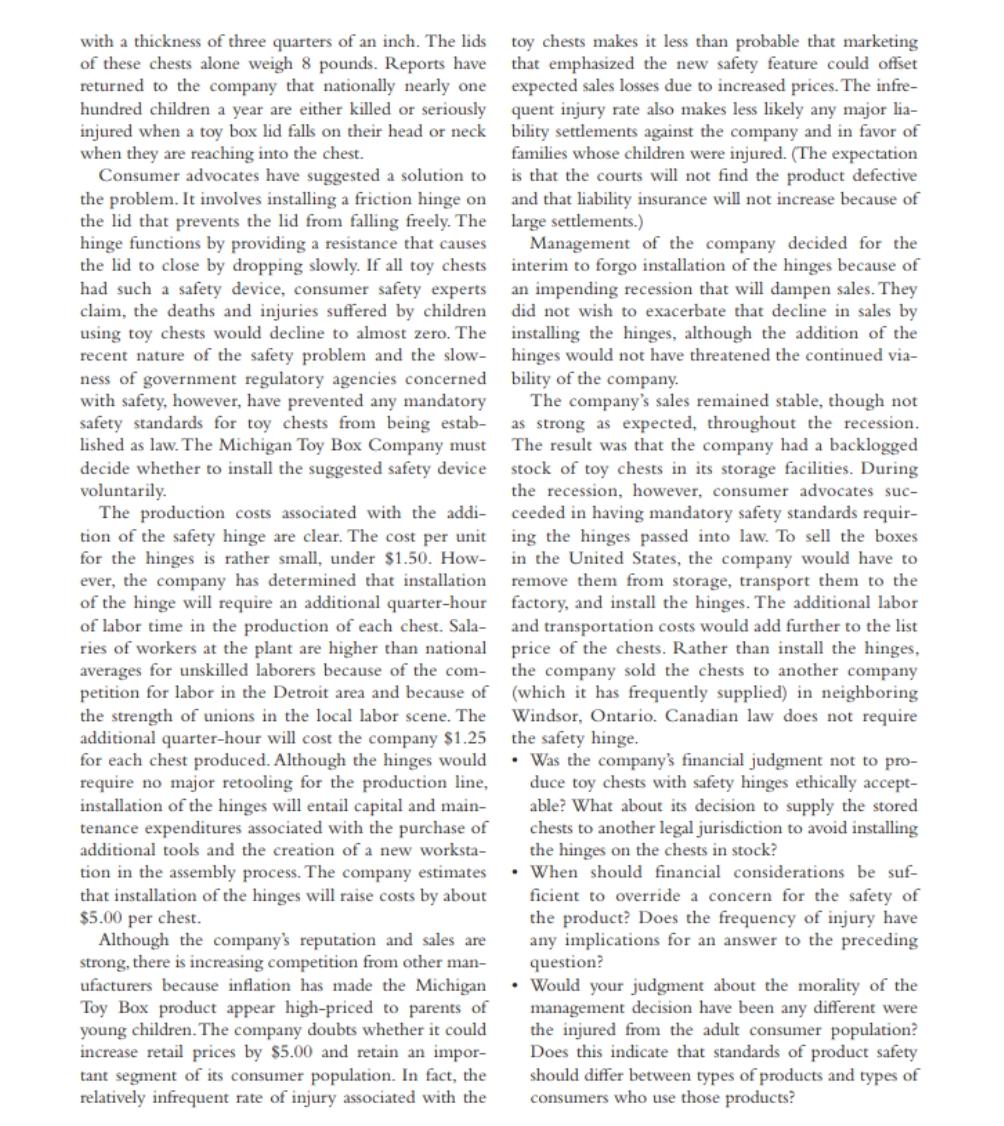Answered step by step
Verified Expert Solution
Question
1 Approved Answer
In the Decision Scenarios point out either the similarities or differences in the dilemmas they raise regarding liability and consumer safety. In answering this question,
In the Decision Scenarios point out either the similarities or differences in the dilemmas they raise regarding liability and consumer safety. In answering this question, you can assume the reader is familiar with the basic facts of the case and go right to comparing and contrasting what's at stake in each case.

with a thickness of three quarters of an inch. The lids of these chests alone weigh 8 pounds. Reports have returned to the company that nationally nearly one hundred children a year are either killed or seriously injured when a toy box lid falls on their head or neck when they are reaching into the chest. Consumer advocates have suggested a solution to the problem. It involves installing a friction hinge on the lid that prevents the lid from falling freely. The hinge functions by providing a resistance that causes the lid to close by dropping slowly. If all toy chests had such a safety device, consumer safety experts claim, the deaths and injuries suffered by children using toy chests would decline to almost zero. The recent nature of the safety problem and the slow- ness of government regulatory agencies concerned with safety, however, have prevented any mandatory safety standards for toy chests from being estab- lished as law. The Michigan Toy Box Company must decide whether to install the suggested safety device voluntarily. The production costs associated with the addi- tion of the safety hinge are clear. The cost per unit for the hinges is rather small, under $1.50. How- ever, the company has determined that installation of the hinge will require an additional quarter-hour of labor time in the production of each chest. Sala- ries of workers at the plant are higher than national averages for unskilled laborers because of the com- petition for labor in the Detroit area and because of the strength of unions in the local labor scene. The additional quarter-hour will cost the company $1.25 for each chest produced. Although the hinges would require no major retooling for the production line, installation of the hinges will entail capital and main- tenance expenditures associated with the purchase of additional tools and the creation of a new worksta- tion in the assembly process. The company estimates that installation of the hinges will raise costs by about $5.00 per chest. Although the company's reputation and sales are strong, there is increasing competition from other man- ufacturers because inflation has made the Michigan Toy Box product appear high-priced to parents of young children. The company doubts whether it could increase retail prices by $5.00 and retain an impor- tant segment of its consumer population. In fact, the relatively infrequent rate of injury associated with the toy chests makes it less than probable that marketing that emphasized the new safety feature could offset expected sales losses due to increased prices. The infre- quent injury rate also makes less likely any major lia- bility settlements against the company and in favor of families whose children were injured. (The expectation is that the courts will not find the product defective and that liability insurance will not increase because of large settlements.) Management of the company decided for the interim to forgo installation of the hinges because of an impending recession that will dampen sales. They did not wish to exacerbate that decline in sales by installing the hinges, although the addition of the hinges would not have threatened the continued via- bility of the company. The company's sales remained stable, though not as strong as expected, throughout the recession. The result was that the company had a backlogged stock of toy chests in its storage facilities. During the recession, however, consumer advocates suc- ceeded in having mandatory safety standards requir- ing the hinges passed into law. To sell the boxes in the United States, the company would have to remove them from storage, transport them to the factory, and install the hinges. The additional labor and transportation costs would add further to the list price of the chests. Rather than install the hinges, the company sold the chests to another company (which it has frequently supplied) in neighboring Windsor, Ontario. Canadian law does not require the safety hinge. . Was the company's financial judgment not to pro- duce toy chests with safety hinges ethically accept- able? What about its decision to supply the stored chests to another legal jurisdiction to avoid installing the hinges on the chests in stock? When should financial considerations be suf- ficient to override a concern for the safety of the product? Does the frequency of injury have any implications for an answer to the preceding question? Would your judgment about the morality of the management decision have been any different were the injured from the adult consumer population? Does this indicate that standards of product safety should differ between types of products and types of consumers who use those products?
Step by Step Solution
★★★★★
3.43 Rating (156 Votes )
There are 3 Steps involved in it
Step: 1
No the company s financial judgment not to produce toy chests with safety hinges eth ically acceptable The company decided not to install the safety h...
Get Instant Access to Expert-Tailored Solutions
See step-by-step solutions with expert insights and AI powered tools for academic success
Step: 2

Step: 3

Ace Your Homework with AI
Get the answers you need in no time with our AI-driven, step-by-step assistance
Get Started


